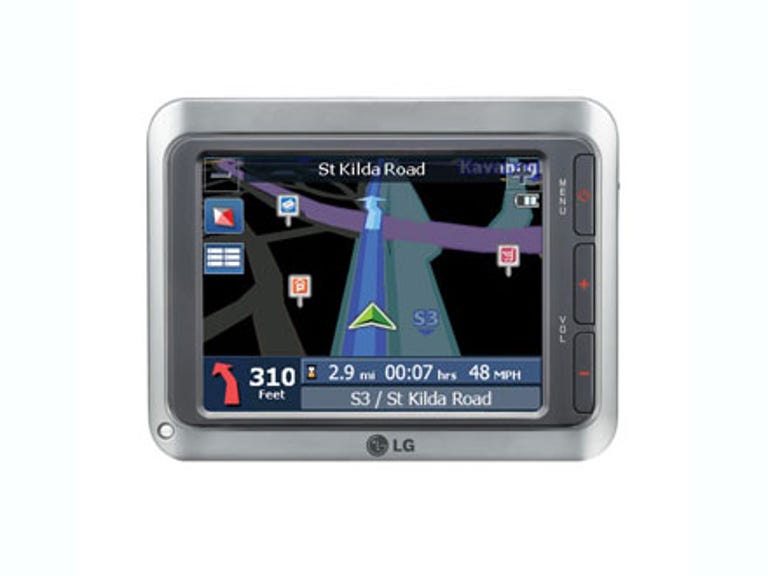 Why You Can Trust CNET
Why You Can Trust CNET LG LN800 review: LG LN800
The LN800 is a solid first crack at the Aussie GPS market with its good looks, light sensor and text-to-speech, but it may not be enough to tempt punters.
Design
LG's LN800 is basically a flat rectangular block with nicely bevelled edges, but for a portable GPS it's a pretty smart looking device. It has a faux metal bezel and the dark grey plastic body has a nice, quality feel to it. Strangely, though, it doesn't look quite as classy as its cheaper sibling the AU$549 LN500. The LN800 felt solid too, giving us the impression that it was heavier than its quoted 200g.
The Good
The Bad
The Bottom Line
To the right of its four-inch touchscreen are the power/menu and volume buttons, which light up a pleasing shade of red at night. On the bottom of the unit is an easily accessible pen reset pin. There's an SD card slot (for music and photos) and a mini-USB connector with a plastic cover along the left-hand edge, while on the right there's a power jack and an on/off slider -- the power/menu button on the front of the LN800 merely puts the unit into sleep mode. The supplied in-car holder has a tabbed suction cup and an open/close switch, which made it easy to attach and detach, and it slips in easily along the backside of the GPS.
Although they sometimes took a second or two the load, the menus are well laid out. We were annoyed with the positioning of the "Map" on-screen button, often it was on the left, sometimes in the middle and other times it just goes AWOL. Its inconsistent location makes it difficult, and potentially dangerous, to return to map-view when driving.

Where on earth is What Le Street?
Most text-to-speech systems struggle with Australia-centric street names, and the LG LN800's is no exception. Listen to a few of its more humorous attempts:
Glebe Point Road
Parramatta Road
Wattle Street
Features
The LN800 is the cheapest GPS we've tested to date which has text-to-speech. So, instead of generic instructions, like "turn left in 300 metres", you get much more helpful ones, like "turn left in 300 metres on to George Street". As we expected, LG didn't attempt to localise the LN800's voice and, as such, it has problems pronouncing words of Aboriginal origin. (We've compiled some of the LN800's more humorous efforts in the side-bar to the right.) Unfortunately the quirks don't end there: roundabouts are erroneously referred to as traffic circles and some roads are referred to by their code number -- for example, Stanmore Road is called S54 according to the LG.
Another feature we liked was the LN800's light sensor -- it's that LED-like thing at the bottom-left of the screen -- which automatically adjusts the screen brightness and contrast, as well as switching between day and night modes. It's a shame, then, that in night mode the colours for the suggested route and for main streets clash badly -- they're both similar shades of blue.
Running Windows CE 5, it's no surprise that the LN800 lets you can listen MP3 or WMA encoded music, as well view photos, stored on an SD card. Given the paucity of pixels (320x240) spread out across the LG's 4-inch screen, viewing photos is a less than pleasurable experience. Music meanwhile can only be played through the LN800's rear-mounted mono speaker -- there's no headphone jack or Bluetooth of any kind. We imagine the number of people who'll be impressed by the LG's multimedia capabilities will very close to zero.
Performance
As a source of directions, we found that the LN800 performed well, although our normal grizzle remained: the routes chosen, while feasible, were often less than optimal given variables like traffic conditions. On a few occasions, though, it surprised us with routes which locals would be proud of. More often than not, especially in our 'hood, we'd wander off the LN800's prescribed course and when we did so, the LN800 would give us a fair bit of latitude -- a few hundred metres, we guess -- before re-calculating the route, which is less than ideal in some inner-city conditions. Route re-calculation was fairly speedy, especially considering the LG's rather average 276MHz processor.
Although LG claims that the LN800 has a five hour battery life, we never really tested this claim out as the unit was usually plugged into the in-car charger. We were rather shocked to note that when starting up the LG every morning out of sleep mode, one out of the three bars in the battery graph had disappeared. Restarting from sleep mode is nearly instantaneous, while starting it up using the on/off slider takes about half-a-minute.
As we discovered when we tested the TomTom One XL, the Sensis mapping data that's used in the LN800, and almost all Australian GPS units, is less than perfect: there are phantom streets, roundabouts where there aren't any and missing traffic restrictions.


